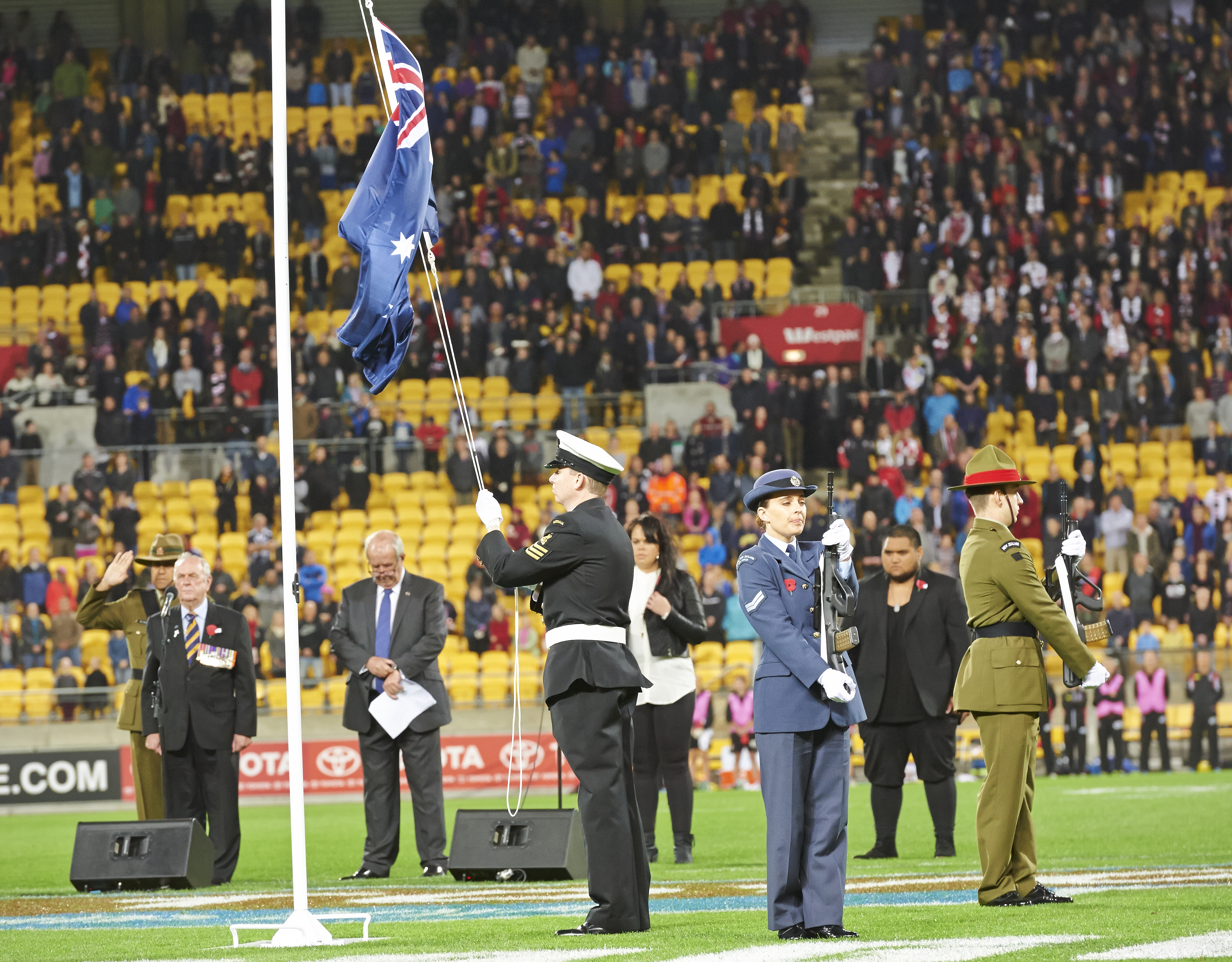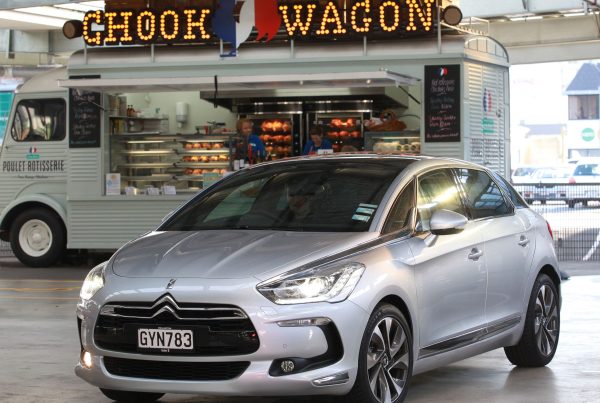For a country where sport is such an important and oft-celebrated part of its cultural framework, New Zealand is strangely bereft of traditional sporting fixtures, even more so when it comes to celebrating days of national significance. Waitangi Day has never had any event attached to it, and Anzac Day has never had any associated sporting traditions, despite being in the middle of the rugby union and league seasons.
Even the much-vaunted traditional “Basin Reserve traditional Boxing Day test” is now neither traditional nor at the Basin Reserve. It took place on only four occasions, but the fact that it is still referred to as a tradition shows that people realise there is a void out there.
The main sporting events that occur in the same place at the same time every year are Christchurch’s racing week, and the Wellington Sevens. That emphasises the void even further.

Maverick Weller of the Saints is tackled by Ryan Griffen of the Bulldogs during the 2014 AFL Round 20 match between the St Kilda Saints and the Western Bulldogs at Etihad Stadium, Melbourne on August 10, 2014. (Photo: Michael Willson/AFL Media)
This vacancy is now being filled by an unlikely source. The St Kilda Australian Football League match in Wellington is a slick affair, and is about so much more than just the match on Anzac Day.
Last year saw a not-unexpected drop-off in crowd numbers from the inaugural event, and there were various reasons for that. The ‘difficult second album’ syndrome was always likely. Last year missed out on the novelty factor from year one, both in terms of local following and those making the trip from Australia. It also coincided with school holidays in both countries, which pushed up trans-Tasman airfares as well as emptying out Wellington.
However, when match day arrived, they managed to create an experience subtly different from normal fare at Westpac Stadium. A giant screen was erected on the Fran Wilde Walkway showcasing the sport and its history. That may seem like a small gesture, but it acted like a giant electronic welcome mat: yes, you are back at a familiar place, but this is different.
St Kilda’s effervescent mascot, who of course is called Trevor, had been busy all week and greeted spectators as they arrived at the game. Fire-eaters were outside the stadium; inside, a brass band circled the concourse, there were prizes for spinning the wheel and there was plenty of merchandise on sale. Interestingly, the queues appeared to be full of New Zealanders.
This is what pleased St Kilda management the most: a connection developing between the locals and the club that has invested in the idea. A real bond will take time, but it has started.
A feature of the event was the Anzac Day pageantry: the ‘Last Post’, the speeches, the flags, the double anthems and the silence. An eerie silence, observed with reverence by over 99 percent of those at the ground. Say what you like, the Australians do this very well.

St Kilda players Josh Saunders and jack Steven flanking Wellington City deputy mayor Justin Lester at the 100 Day Countdown to Anzac Day event in January. Photo: Clive Pigott.
St Kilda lost, as they had the previous year, but supporters of Wellington-based sides are used to this. On the positive side, this was a good match — unlike the dew-affected, muddling, spill-the-ball affair from the previous year. From a pure sporting perspective, those at the match would be more tempted to return than those at the 2013 model. St Kilda will want to start winning here though; they will not want a ‘Warriors at Eden Park’ scenario.
On the day following the match there was a family day at the Basin Reserve, where the players mingled with fans and children, as well as conducting basic drills, and on the Sunday there was a game between the New Zealand Hawks and a South Pacific side. That capped off a week of all-round promotion of the club, but more importantly, the game in New Zealand. Heavily involved in this was AFL New Zealand, who are actively promoting the code here after decades of relative inactivity.
The sport does have a history in this country. The first recorded game of Victorian Rules, as it was known then, was in Nelson in 1868. (Nelson also hosted the first game of rugby union; pioneers all round.) A Māori rugby team did a world tour in the 1880s, finishing up in Australia and playing St Kilda, of all teams, in a series of Victoria Rules matches. In the 1890s, there were 44 clubs in New Zealand. The sport kept its hold in this country up until the First World War, after which it mysteriously vanished.
In the last five years that has turned around, due to a concerted push from AFL New Zealand, and with more than a little help from head office across the Tasman. The focus is on getting children, particularly those aged 7–12, involved in the sport. Importantly, the sport is played over summer, not just because those shorts and singlets are not made for a New Zealand winter, but so that it is not in direct competition with the other oval ball codes.
Kiwikick was introduced into a huge number of primary schools across New Zealand, with strong involvement from the Hawthorn Hawks. All that the young kids (30,000 and counting) had to do was sign up and learn the basics for an hour or so after school on a weekday, and they came away with a brown and yellow cap, a brown and yellow bag, and a brown and yellow football.
As a result of that initiative, Shem Tatupu and Kurt Heatherley are now on the roster at Hawthorn. Heatherley was recently heavily involved in the pre-season NAB Cup, playing every match for Hawthorn with distinction, and was on the fringes of being selected in the Week 1 team for Hawthorn — no easy feat given the depth of talent in that side.
Naturally, the primary club involved in talent-spotting is now St Kilda, although the vast majority of clubs were involved in the latest combine, or trials in New Zealand speak, to be held here. From that, Giovanni Mountain-Silbery, owner of the coolest name in New Zealand sport, got signed onto the roster at St Kilda.
Mountain-Silbery had no background in the sport whatsoever. He was a talented schoolboy from South Auckland with a background in athletics and rugby union. However, he excelled at all the relevant drills, and is getting coached in the sport while finishing his schooling and taking up his contract with St Kilda. He joined Joe Baker-Thomas from Porirua, who has a rugby and high-jumping background.
St Kilda’s latest signing is Christchurch teenager Barclay Miller, who has a basketball background. The 16-year-old was in the Canterbury Rams squad last year, so he is clearly an impressive athlete. The ties between St Kilda and New Zealand are strengthening, and the talent pool is being tapped. It is a lot easier teaching a 16-year-old how to play a new sport than it is converting a 29-year-old rugby league player into a rugby union number 10.
AFL New Zealand is also supported by the Australian High Commission, which has a particular focus on the development and support of indigenous sport in both countries. In addition to the Kiwikick kids, there are around 10,000 children at secondary school level involved.

Australian Breeze v NZ Kahus in the 2014 AFL International Youth Girls Cup at Parrs Park, Oratia
Chief executive Rob Vanstam notes that there are now 80 people in AFL New Zealand. Two of those are Australian, but the rest are New Zealanders. The double benefits of the organisation here are that it generates a pool of local coaches, and it helps those children being coached feel that they are not part of some international social experiment.
With this fledgling involvement of New Zealanders into the professional ranks, the casual follower will find it easier to identify with clubs. The highest-profile player in that category currently is Auckland-born Shane Savage (although he did grow up in Melbourne).
So what is in store for the future of this fixture? As with other sports, a shift to a daytime kick-off would have a huge positive effect on crowd numbers. Given that AFL New Zealand’s primary push is at pre-teen children, a 7.45pm kick-off for a match that lasts three hours is not ideal.
That change to an earlier start is exactly what is happening this year. Anzac Day 2015, the centenary of the Gallipoli landing, sees a 1.10pm kick-off. As well as creating a far better time of the day for Wellington fans, it also provides a nice lead-in for viewers being the Tasman as it curtain-raises the traditional Collingwood and Essendon Anzac Day fixture at the Melbourne Cricket Ground.
The real bonus of this scheduling is that it makes the event so much more accessible for children. This ties in much more favourably with that AFL New Zealand strategy of focusing development effort on those aged 7–12. Nothing drags a parent along to an event quite like an enthusiastic child.
For the first time, St Kilda’s opponent is another Melbourne club. Carlton, 16-time premiership winners and a foundation member of the AFL, will bring their huge following with them.
Both sides will hold open training sessions at Westpac Stadium on the 24 April. That is a school day, and organisers are working closely with primary schools to encourage as many children as possible to attend. It is hoped that the number of people turning up to these sessions will be in the thousands.
Also on that day, the National League Academy Tournament — involving three teams — is taking place at Hutt Park, and there is a display of AFL skills at the TSB Arena the previous evening. A youth team from South East Victoria is also making the trip over the Tasman to play a New Zealand under-16 side, and the Basin Reserve will once again play host to an open day on the day after the match. A thousand people attended that event last year, and that number is expected to grow.
As you can see, the AFL are thinking 20 years ahead here. As they did with their expansion into Sydney and Brisbane — a venture most thought would never succeed — they are concentrating on establishing the game at grassroots level while having regular elite guest matches. It is of note that even Adelaide and Perth, despite being AFL heartland cities, got permanent franchises only in the 1990s.
It is a model the AFL are familiar with, and the deep pockets in Melbourne will know how to invest, and can take a short-term hit if required. Should the dream of an AFL team based in New Zealand become reality, it will be a carefully planned introduction. And as things stand at the moment, there is only one ground in the country that could host such a venture.






